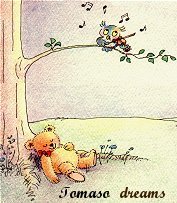 Have you ever dreamed about playing a difficult violin solo? Have you ever heard it played and really wanted to try to do that? The sounds created by the violinist living in your head. The theme staying in your
mind long after the notes have stopped. Thinking........if I practice enough would I be able to at least master that solo enough to enjoy playing it? You buy the printed music and you study it, even mark some fingerings and bowings. You look for recordings of the selection and then
compare to see which style you like the best. Then quietly, when you are alone at the house, you take out your violin and tune it up and try the first notes. Where will it go from here? Will you be able to play the entire solo someday? How hard are you willing to work and how many hours of practice can you put towards it? Have you ever dreamed about playing a difficult violin solo? Have you ever heard it played and really wanted to try to do that? The sounds created by the violinist living in your head. The theme staying in your
mind long after the notes have stopped. Thinking........if I practice enough would I be able to at least master that solo enough to enjoy playing it? You buy the printed music and you study it, even mark some fingerings and bowings. You look for recordings of the selection and then
compare to see which style you like the best. Then quietly, when you are alone at the house, you take out your violin and tune it up and try the first notes. Where will it go from here? Will you be able to play the entire solo someday? How hard are you willing to work and how many hours of practice can you put towards it?
Tomaso d-r-e-a-m-s 
Tomaso Antonio Vitali Chaconne
 Tomaso Bear presents his guide to the Tomaso Vitale Chaconne.
A chaconne is a set of variations over a ground. It is also spelled Ciaconne and is a fiery and suggestive dance that appeared in Spain about 1600 and eventually gave its name to this musical form. Tomaso Antonio Vitali was born in Bologna, Italy March 7, 1663 and died May 9, 1745. He was a violinist who was taught by his father. He was leader of the Este orchestra from 1675-1742. There are many Vitali Chaconnes. It was originally written for violin and basso continuo and the first famous publication by Ferdinand David (1810-1745) was published posthumously . He "enhanced" it to be a virtuoso showpiece rather than the original which is more in the style of the Bach Chaconne. The original doesn't have any of the octave or really high parts and the piano part is also very bare. There is even some doubt now whether it was actually by Vitali at all. Most people record the Leopold Charlier version although the original is also played but people really consider them as two separate pieces because they are so totally different. Ferdinand David's set the tone for the many following interpretations that were written. The one I am going to discuss is the Leopold Charlier arrangement. If you play the Charlier arrangement you need to go for it, no holding back. Tomaso Bear presents his guide to the Tomaso Vitale Chaconne.
A chaconne is a set of variations over a ground. It is also spelled Ciaconne and is a fiery and suggestive dance that appeared in Spain about 1600 and eventually gave its name to this musical form. Tomaso Antonio Vitali was born in Bologna, Italy March 7, 1663 and died May 9, 1745. He was a violinist who was taught by his father. He was leader of the Este orchestra from 1675-1742. There are many Vitali Chaconnes. It was originally written for violin and basso continuo and the first famous publication by Ferdinand David (1810-1745) was published posthumously . He "enhanced" it to be a virtuoso showpiece rather than the original which is more in the style of the Bach Chaconne. The original doesn't have any of the octave or really high parts and the piano part is also very bare. There is even some doubt now whether it was actually by Vitali at all. Most people record the Leopold Charlier version although the original is also played but people really consider them as two separate pieces because they are so totally different. Ferdinand David's set the tone for the many following interpretations that were written. The one I am going to discuss is the Leopold Charlier arrangement. If you play the Charlier arrangement you need to go for it, no holding back.
 When the violin opens with the theme. The first 2 phrases makeup the theme. One should try to create an expansiveness with the sound. The bow should be like taffy with uninterupted sound. It is written upon repeated four-measure phrases and builds to a climax.
are done by changing douples to triples.   Dolce begins in measure 45 with another variation of (did I mention 8 measures?). Four plain and 4 fancy and four even fancier. The middle one being leggiero ( lightly) and the last one being
 Vitali Chaconne in g minor Vitali Chaconne in g minor
|


 Violin
Violin sheilascorner Home
sheilascorner Home Photography
Photography Websites
Websites

 Recordings
Recordings
